
Tuesday | September 12, 2017
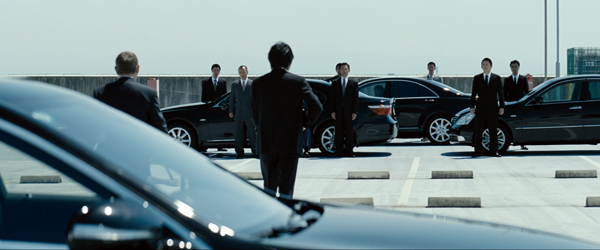
Outrage Coda (2017).
DB here:
The period from 1985-1995 was a sterling era for world cinema. Whatever you think of Hollywood of that time (it wasn’t as bad as they say), American independent film was flourishing then. On the global stage, things were even better, as witness the rising careers of Hou Hsiao-hsien, Edward Yang Dechang, Jackie Chan, Tsui Hark, Abbas Kiarostami, and Wong Kar-wai. It was exhilarating to watch these and other directors turn out splendid work like City of Sadness, A Brighter Summer Day, Police Story, Project A Part II, Peking Opera Blues, Once Upon a Time in China, The Blade, Where Is the Friend’s Home?, Through the Olive Trees, Days of Being Wild, Chungking Express, and more.
That’s not all. In Hong Kong, John Woo was redefining the urban action film with the flamboyant, romantic A Better Tomorrow (1986), The Killer (1989), and Hard-Boiled (1992). In Japan, a standup comedian known as “Beat” Takeshi Kitano took over the helming of a crime thriller, Violent Cop (1989), and decided to continue directing, turning out not only the bored-hitman saga Sonatine (1993) but also the lyrical A Scene at the Sea (1991). Another Japanese filmmaker, Kore-eda Hirokazu, launched his career with the meditative, Hou-ish Maborosi (1995).
I loved these films, and still do. Woo and Kitano belong to an older generation (mine, actually), while Kore-eda is younger. None has gone away. All came to Venice 74 with murder on their minds.
Confessed, but to what?

The Third Murder (2017).
The Third Murder (Sandome no satsujin) is Kore-eda’s first venture into the crime genre, and he brings to it the same steady humanism we find in all his work. I’ve elsewhere recorded my uneasiness with his current visual style. Unlike the grave, long-take Maborosi, his films of the last decade or so are pictorially conventional, even academic, with their big close-ups, needlessly sidling camera moves, and other features of intensified continuity. But he continues to take narrative risks, and his almost Renoirian willingness to see many moral and psychological points of view make every film fairly gripping.
The Third Murder begins abruptly. An unseen victim is bludgeoned and the body is burned. The killer is the man we’ll come to know as Misumi. He’s captured. Like 99% of people charged with crimes in Japan, he readily confesses. His lawyers face only the question of sentencing: Should they try to get him life imprisonment rather than execution? When one attorney, Shigemori, decides to investigate more closely, he peels back layers of uncertainty about the circumstances, the victim, and the motive(s). Like many a victim in crime fiction, this businessman needed killing.
Following conventions of the investigative procedural, the plot relies on secrets, viewpoint shifts that drop hints, twists that frustrate simple understanding, and flashbacks that make us question what we thought we knew. Shooting in anamorphic widescreen, Kore-eda produces some extreme framings reminiscent of Kurosawa’s High and Low, one of the films he studied while preparing the project. Despite occasionally flashy moments, it’s a soberly told tale, emphasizing characterization and social critique. By the end, Misumi acquires a weary, radiant dignity, while entrepreneurial capitalism and the justice system are revealed as compromised. (In this respect it recalls I Just Didn’t Do It, 2007, by another 80s-90s director, Suo Masayuki.) In moving to the sordid terrain of the crime story, The Third Murder shows that Kore-eda hasn’t given up his sympathetic probing of human nature and his praise for un-grandiose self-sacrifice.
Bullets to the head and elsewhere
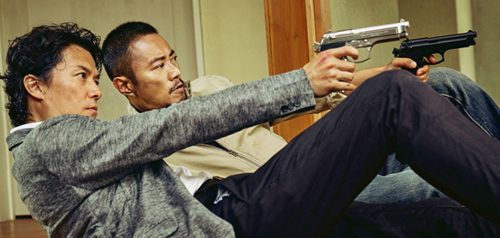
Manhunt (2017).
Sober and un-grandiose don’t apply to Manhunt (Zhuibu), John Woo’s return to bloody brotherhood and outsize ordnance. After prestige Hollywood efforts like Windtalkers (2002), the nationalistic costume picture Red Cliff (2008-2009), and the ensemble-disaster movie The Crossing (2014-2015), Woo is back with what he does best: showing many people firing many guns, dodging bullets (bad guys have bad aim), diving for cover in slow-motion, floating through hazes of cordite, and instantly recovering from wounds that would finish off you and me. These characters also run endlessly, hop into the path of trains, overturn vehicles, and set loose unconscionable numbers of pigeons.
1990s Hong Kong directors could make cheap pictures look expensive; given bigger budgets, they made expensive pictures look cheap. Here that cheapness shows most in some video-generated shots that recall the bad old days of edge enhancement. But who has time to study such problems when you’re smacked by a fusillade of 3000-plus shots in 105 minutes? Resistance is futile, and the pace doesn’t relent. When the fights and pursuits pause, the dialogue scenes flash by in a flurry of cuts and unfortunate lapses into English. (Much of the soundtrack recalls the eerily dubbed voices on US videos of The Killer.)
You’ve got no time to worry much about all this after an opening that drops us straight into an ambush. Ultra-cool Du Qiu drifts into a bar and quotes yakuza movies before leaving the hostesses to slaughter the gangsters dining there. It does get your attention, and it encourages you to sit through the exposition showing Du as the trusted lawyer for a corrupt pharmaceutical company. He proceeds to be framed for murder and goes on the run. Meanwhile stalwart detective Yamura, charged with bringing Du in, begins to suspect that there’s a bigger scheme afoot. Of course he is right.
This is all completely preposterous and continually enjoyable, with constantly startling action choreography and an overheated soundtrack that at one point breaks into Turandot. Here those damn pigeons don’t just soar into the sky; thanks to CGI, they flap annoyingly into the middle of fight scenes, spoiling a punch or a gunman’s aim. We have, besides our twinned heroes, one corrupt cop, one psychopathic son, one fairly mad scientist, two expert hitwomen (one played by Woo’s daughter), a fleet of black-suited motorcycle assassins, and two docile women who acquire some non-negligible lethality. In the press conference, Woo emphasized his eagerness to create women warriors, and he hasn’t stinted. There are hallucinatory images of a bloody wedding dress to enhance the feminine mystique.
Manhunt is a kind of palimpsest of Asian action movies. It’s a remake of a 1978 Takakura Ken movie released to great popularity in China during the 1980s. Woo, in Hong Kong, had already succumbed to that actor’s spell. What Alain Delon was to The Killer, Takakura is to this, and the steelly self-possession of Zhang Hanyu gives the film a solemnity amid all the flamboyance.
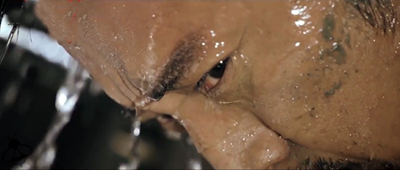
Woo has turned the Japanese original into a real Hong Kong movie, vintage 1992. It lacks the mournful homoeroticism of his prime-period work; these two men don’t gaze moistly at each other, but fire quips and complaints in the Lethal Weapon manner. (The bonding is strongest between the duo of female killers.) Still, it’s very welcome, with its proudly retro air and fanboy in-jokes. It earns the right to begin with a reference to a Japanese classic and conclude with a wink to A Better Tomorrow, as if that movie were the next link in a grand tradition. “Old movies always end this way,” says one of the survivors of the carnage. I wish more new movies did the same.
Hitmen in cars getting shot
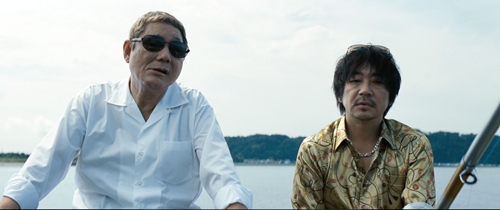
Outrage Coda (2017).
Compared to Woo, Kitano is brutally laconic. In Outrage Coda, except for one Wooish slow-mo massacre, violence is brusque, shocking, and over fast. In a film full of bland pans following yakuza cars here and there, the end of one panning movement bursts into shooting before you realize it’s happening, and it ends just as suddenly. Kitano likes his confrontations, for sure, and sometimes there’s a buildup, but mostly the blood just erupts, punctuating long scenes of gangster intrigue.
Here that intrigue involves three rival gangs, each with bosses capable of remarkable lip contortions: the Hanabishi yakuza family, its once-powerful subsidiary the Sanno group, and a gang of fixers operating in Japan and Korea under the auspices of boss Chang. Add in two cops, one ready to knuckle to corrupt superiors, the other raging against them, and you have the world through which Otomo (Kitano) and his sidekick Ichikawa move. Normal life, as it’s commonly known, has no place here.
The action bristles with schemes, shifting alliances, double-crosses, faked deaths, and power grabs.”Your methods,” remarks one boss to a co-conspirator, “are increasingly more intricate.” Remarkably, after an introduction humiliating the not-so-bright Hanaba during a sexcapade, Otomo isn’t seen that much. Two-thirds of the running time are devoted to the machinations of the gangs and the cops. Otomo and Ichikawa swing into action rather late, their task being to chop through the knots of plot and counterplot.
The opening few minutes spread out the key motifs. A fishing scene displaying Kitano’s characteristic love for boyish pastimes is interrupted by the discovery of a pistol. The credits sequence announces the importance of cars with gorgeous shots of Otomo being driven through neon-lit streets, his ride seen from straight down as lights play over it. Throughout, deals are struck or broken in cars, and one memorable execution makes creative use of a Toyota. Even that banal filler, shots of cars pulling up and disgorging their riders, gets played for variations: distant thunder when bosses arrive for a conference, abstract configurations when rival forces meet on a rooftop.
During the 1990s Kitano was one of those directors working with what I’ve called planimetric staging and compass-point editing. (Wes Anderson, Terence Davies, and others worked the same territory.) Characters face the camera in medium shot, and shots change along the lens axis or at 90 degrees to it. It’s as if we were in between the characters. When I asked Kitano about the technique back then, he claimed that it was his effort at realism, capturing how people faced one another in conversation. He added that he didn’t know how to direct a scene, and this was the easiest way.
I thought that his images’ paper-doll simplicity suggested a naivete suited to Kitano’s childish hitmen. Moreover, this rigorous, geometrical technique takes on special impact when presenting mobster shootouts. Instead of ducking for cover as Woo’s heroes do, Kitano’s stand up and keep blasting, firing straight out at the viewer in tit-for-tate exchanges. His unflinching framing, refusing Woo’s camera arabesques, gives these encounters a ceremonial gravity, turning them into rituals of professional righteousness. Last man standing, indeed.
The face-to-face shootouts in Outrage Coda adhere to this style, and early in the film so do the conversations. Here is Otomo discovering Hanada in his masochistic rig.
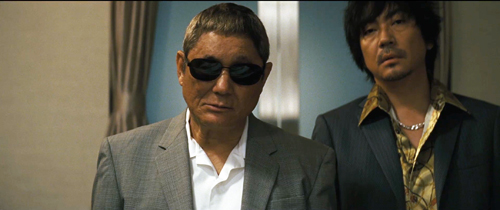 
But for many dialogue scenes Kitano has gone with more orthodox staging and shooting. We get over-the-shoulder shots for conversation, tight close-ups to emphasize character reactions, and even that commonplace of modern cinematography, the arcing movement around a speaker to pick up a listener in the background. These choices allow Kitano to expose the ripe performances of the two conspiratorial dons Nishino (Nishida Toshiyuki) and Nakata (Shiomi Sansei); their leathery skin, slip-sliding jaws, and shouted outbursts gain a lot from this treatment. Not that I’m really complaining. In a slightly longer film than Manhunt, Kitano gives us around 700 shots, less than a quarter of Woo’s outlay. Each image carries a lot of weight.
Outrage Coda concludes a trilogy, and at the press conference Kitano said that he conceived this and Outrage Beyond (2012) as one continuous phase of the story. He wanted the series to finish. The ending of this installment will fuel much speculation about his next move, and he hinted that he might adapt a forthcoming novel, one that’s a love story. He’s done one before in A Scene at the Sea, and arguably in Kikujiro (1999). His fans, who mobbed him at the panel, are certainly ready for whatever he comes up with.
Thanks as ever to all those at the Venice Film Festival who made our stay so enjoyable. Special thanks to Peter Cowie, Alberto Barbera, Michela Nazzarin, Jasna Zoranovich, and our colleagues at the Biennale College Cinema endeavor.
For more on John Woo’s style of action cinema, see my book Planet Hong Kong. I discuss planimetric staging and compass-point editing in On the History of Film Style and several blog entries, notably the persistently popular Shot-consciousness (which has side notes on Kitano) as well as entries on Wes Anderson.
 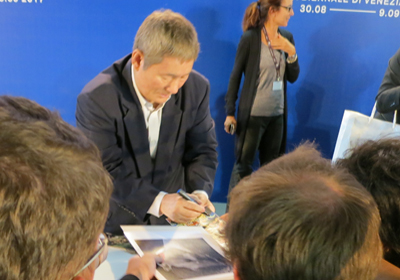
John Woo and Kitano Takeshi satisfy their fans.
Posted in Directors: Kitano, Directors: Kore-eda Hirokazu, Directors: Woo, Festivals: Venice, Film comments, National cinemas: Hong Kong, National cinemas: Japan |  open printable version
| No Comments » open printable version
| No Comments »
Saturday | September 9, 2017
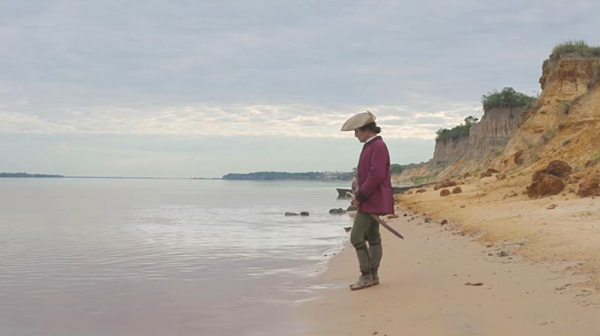
Kristin here:
Lucrecia Martel’s Zama (pronounced “sama”) happened to be only the third film we saw at the Venice International Film Festival, on the evening of its first day. As the credits faded, David asked, “Have we just seen a masterpiece?” Neither of us doubted that we had, and we suspected that we had also watched the best film we would see during the entire festival. Of course, we haven’t seen every title on offer here, but having just come back from my twenty-fourth and final film, I don’t doubt that it is.
It is also a challenging film, which we watched a second time to try and grasp the basics of what plot there is. Those of us who admired Martel’s earlier work, particularly The Headless Woman (which we also felt compelled to watch twice, this time at the Vancouver International Film Festival in 2009 and wrote about here), had looked forward to her follow-up film. It was eight years in coming, and it is quite different from her earlier films in several ways.
First, while the three earlier features are set set in modern middle-class milieus, Zama is a period piece. The others had original screenplays, written or co-written by Martel, but Zama is based on a 1956 novel by Antonio Di Benedetto (translated into English in 2016). Martel was also working with a higher budget here, one which required patching together many sources of financing. The result is a co-production involving, Argentina, Spain, France, the Netherlands, the USA, Brazil, Mexico, Portugal, Lebanon, and Switzerland and a patchwork of sixteen companies. At the press conference (below) Martel said that the long gap between films was not occupied with making all these arrangements and with shooting the film, which was actually a reasonably short process. She did make a few short films during this time and was ill enough to cease working for a while.
The result of the film’s elaborate production situation is not a typical historical epic. There are impressive landscape shots in some scenes, but no uniformed crowds and grand buildings. No vast battles take place; instead there are a few small skirmishes. The bulk of the action takes place in a ramshackle group of buildings thrown up to house the Spanish colonial government of the provincial town of Asunción, already in decline by the 1790s. The money clearly was spent on creating authentic costumes and furnishings, as well as transporting the cast and crew to locations in Paraguay.
Frustrations of a colonial bureaucrat
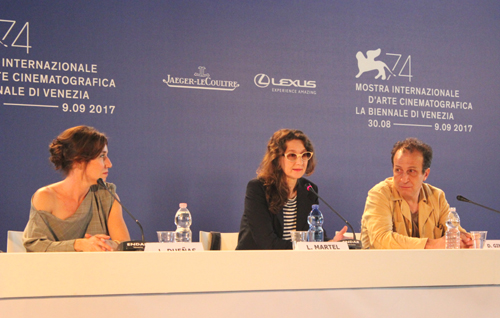
Lola Dueñas (Luciana), Lucretia Martel, and Daniel Giménez Cacho (Zama).
We quickly learn the story’s basic premise, that Don Diego de Zama is an official stationed in this backwater town and that he fervently longs to be transferred to a more important city–ideally where his wife and children live. He is not in charge of this outpost but serves under a governor whose request to the Spanish crown is necessary for such a transfer.
We are certainly not invited to like Zama when we first meet him. The first shot shows him standing and looking down the river (see top). We later learn that he was probably watching for the boat carrying mail, which he hopes will include a letter from his wife or some official news concerning his situation. He spies on some naked indigenous women smearing themselves with mud, and when they taunt and chase him, he turns on one and slaps her viciously. In the second scene he presides over the torture of a young man who refuses to divulge some unspecified information the governor needs.
As the action proceeds, however, we witness the countless little frustrations, embarrassments, bafflements, slights, and misfortunes that Zama seems to experience constantly. A brandy merchant who arrives with his wares, seemingly one of Zama’s few friends (below), dies suddenly of the plague. Luciana, a wealthy local beauty, teases him with suggestive conversation but ultimately takes a younger man as a lover. A new governor’s arrival hints that Zama is back to square one as far as his hopes for a transfer are concerned. The man takes over Zama’s modest home and office, leaving him to haul his sparse furnishings to a barely habitable inn. When no letter from his wife arrives, Zama imagines a conversation with her in which they lament the long delay in their reunion, though we must suspect that her failure to correspond means that she has given up on him. Through all this we come to sympathize with him. We never learn how long he has been in this posting, but when someone asks he replies glumly, “a long time,” and we believe him.
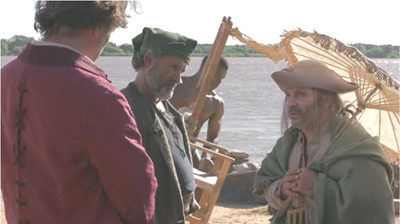
Zama might seem at first to be the epitome of a goal-oriented protagonist, but he is hardly the striving, active Hollywood-style hero. There is nothing he can do to better his current situation or to further his desire for escape. Instead, the action consists of one new, often bizarre challenge after another, creating situations that simply play out, usually to no conclusion. None of these situations furthers Zama’s cause. Gradually we become aware that he is actually losing ground, as when the new governor reveals that he must write not one but two letters to the king, a process that could take a year or two. The final portion of the film takes him in a radically new direction as he tries one desperate bid to gain stature and perhaps his long-delayed transfer, a bid that only leads to worse troubles for him.
There is little sense of how much times passes in the course of this accretion of frustrating incidents. During the press conference (above), the cinematographer Rui Poças and Martel said that they sought a visual way to convey a sense of Zama’s agonizing wait, a way to give “the sensation of time that has stopped,” as Martel put it. They deliberately avoided some of the conventions of historical films. One of these was to eliminate fires and candles. Martel added, “In order to be able to think, you must be deprived of things.” This rule was strictly obeyed, with one shot that turned out to contain a candle flame in the background being eliminated. When one thinks about it, lamps, candles, and fireplaces tend to figure quite prominently in suggesting the past in films, which became particularly evident, for example, when a great deal of fuss was made about the new ability to shoot dark scenes only by candlelight in Kubrick’s Barry Lyndon (1975).
Thinking, being deprived of things
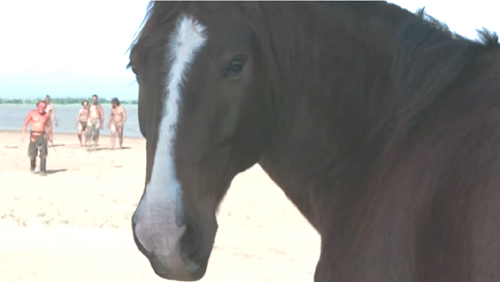
As Martel also pointed out, the original novel was told in the first person by Zama, with few descriptions of locales or nature. The film opens the tale out with the occasional landscape views in the early portions and a move into a savanna setting for its last stretch of action (see bottom). For much of the film, however, Martel uses the style I described in The Headless Woman, ” shooting largely in tight shots filmed with highly selective focus.” We stay almost exclusively with Diego, scanning his face for his reactions, so that the film becomes a psychological study, though the title character is a man who manages to carry on by keeping his thoughts and emotions well hidden.
Mexican actor Daniel Giménez Cacho gives a remarkable performance as Zama. We soon realize that the character has very little understanding of the bizarre things that happen around him and of the attitudes that other people have toward him. At times he adopts the faintest of smiles, ready in case what is being said to him is supposed to be amusing. More often he looks mildly worried, as if expecting another mocking remark or revelation of some new indignity to be offered. In his court his face could be taken to convey an appropriate dignity and wisdom (below), but it might just as well be puzzlement over the case before him. With Luciana he seems passive, but his face conveys hints of lust, hope, and an anticipation of ultimate rejection. In a meeting with a superior official, he struggles to ignore the ludicrous presence of a llama (which we had seen outside when he arrived) wandering around the office behind him as he pleads his case.
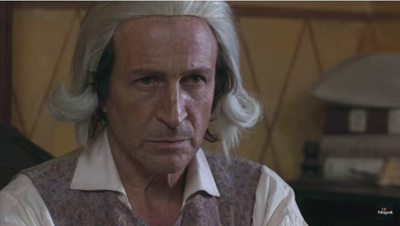 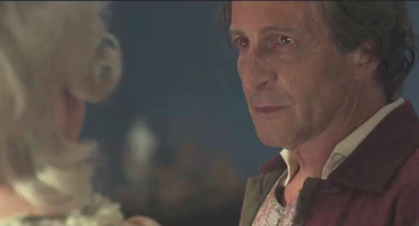
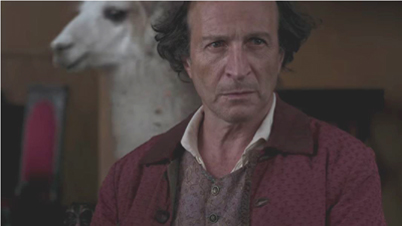
All in all, despite the fact that Cacho’s craggy, earnest face seems to suggest competence, we emerge from the film with no real sense of whether Zama is in fact competent and unfairly treated or simply a man out of his depth who deservedly remains stuck where he is.
One extraordinary moment which I cannot resist mentioning comes late in the film when a horse in the foreground of a scene turns and looks directly into the lens (top of this section). Its stare is even more enigmatic than Zama’s face, just another little mystery that Martel provides.
It is not surprising that Zama was the first in a series of three novels that have come to be called Di Benedetto’s “Trilogy of Expectations.” The second, El silenciero (1964), and third, Los suidicas (1969), share no plot elements with Zama but are thematically linked to it. It is also not surprising to learn that the novelist first read Kafka in 1954, just before writing Zama.
Guy Lodge, in his enthusiastic review for Variety, refers to Zama‘s “unjust placement in a non-competition slot at Venice.” It has garnered quite a few reviews as laudatory as Lodge’s, as well as a few which dismissed it as cryptic and not engaging. A good summary of the coverage, regularly updated, is provided by David Hudson. The film deserves to gain a higher profile in its upcoming screenings at the Toronto and New York festivals. Perhaps it will also pick up a North American distributor. Somehow it should be made available on home video (Criterion, perhaps?), since this is going to be considered a classic.
The most detailed account of Di Benedetto’s life and work available online is an essay by the translator of the English-language version, Esther Allen.
Again, we are grateful to the Mostra and those who serve it, particularly Alberto Barbera and Michela Nazzarin. Thanks as well to Peter Cowie and David’s colleagues on the Biennale College Cinema panel, who have all been good company.
[October 1, 2017: Argentina has chosen Zama as its nomination for best-foreign-language Oscar. I doubt it will make it into the final five, given how challenging it is. Still, maybe it will, and in any case, it’s good to see Martel getting respect in her home country.]
[October 16, 2017: Strand Releasing picked up the North American distribution rights for Zama last month, shortly before its American premiere at the New York Film Festival. It plans a theatrical release in early 2018.]
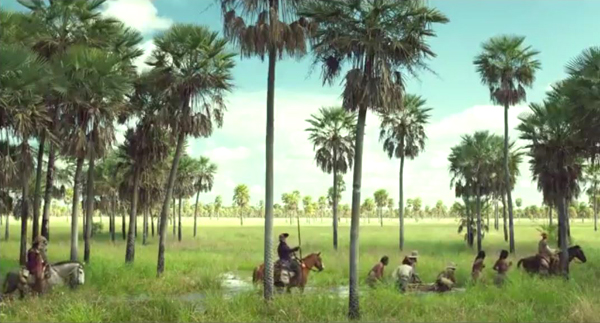
Posted in Directors: Martel, Festivals: Venice, Film comments, National cinemas: South America |  open printable version
| No Comments » open printable version
| No Comments »
Thursday | September 7, 2017
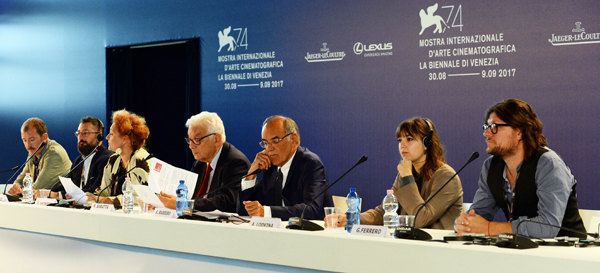
At the College press conference: Pedro Costa, Mazen Khaled, Savina Neirotti, Paolo Baratta, Alberto Barbera, Alena Lodkina, and Giorgio Ferrero. © La Biennale di Venezia – foto ASAC .
DB here:
I came to this year’s Venice Film Festival at the invitation of Peter Cowie, who has for years run panels of critics and filmmakers at the Mostra. In recent sessions he’s assembled gaggles of critics to respond to films made under the auspices of the Biennale College Cinema.
 The College supports creative teams making micro-budgeted first or second features. On the basis of treatments and video presentations, the selectors pick out projects that seem feasible and bring twelve teams to fall workshops, where they work with 18 tutors and trainers. This year’s filmmakers all attest to the strong, provocative challenges they got in the workshops. After three or four weeks, each team submits a draft project. On the basis of the drafts, three projects are picked for final support. The College supports creative teams making micro-budgeted first or second features. On the basis of treatments and video presentations, the selectors pick out projects that seem feasible and bring twelve teams to fall workshops, where they work with 18 tutors and trainers. This year’s filmmakers all attest to the strong, provocative challenges they got in the workshops. After three or four weeks, each team submits a draft project. On the basis of the drafts, three projects are picked for final support.
Past films that have emerged on the international scene from the competition include Memphis (2014) and The Fits (2015). Last year, explained Sabine Neirotti, coordinator of the initiative, there were 1400 applications. This year, each selected project project got 150,000 euros funding.
As Peter’s statement puts it, the College exists to “support the making of low-budget films in a period of global recession” and to “find youthful auteurs if the cinema is to be reinvigorated.” The purpose of the panel is to give feedback to the filmmakers, particularly about how their work might fit into the world cinema market.
This year’s panel gave me a chance to make some new friends: Ty Burr of the Boston Globe, Glenn Kenny of the New York Times and Some Came Running, Chris Vognar of the Dallas Morning News, and Stephanie Zacharek of Time. Kristin and I had already known Justin Chang of the Los Angeles Times. Doing a festival is fun, but doing it with peppy cinephiles like these is even better.
So what about the films? All seemed to me quite good, and each had some very strong moments. All were clearly personal expressions, but each also wanted to communicate vividly with the viewer. All have ripe prospects at festivals and what might lie beyond–home video, streaming, specialty theatrical. And all struck me as having roots in powerful traditions in film history.
Gleams at Lightning Ridge
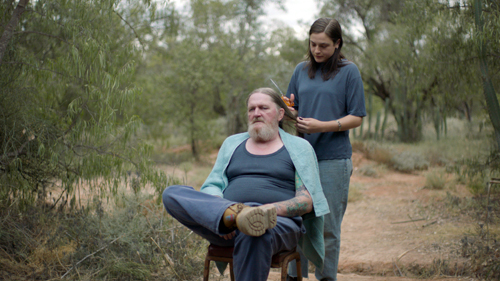
Strange Colours (2017).
Strange Colours, directed by Alena Lodkina, is somewhat akin to American indie regionalism. In the Australian Outback, miners dig for opals, and they live isolated, hard-edged lives. Lean and raggedy coots gripping cans of light beer from dawn to bedtime, shuffling along and muttering through overgrown beards, they might seem an alien tribe. Many confess they came here as a last resort and stayed because they liked the solitude. Eventually, the contours of a genuine, robust community come into focus through the visit of Milena, an outsider who has come on a family mission.
Taking a break from university, Milena is in Lightning Ridge because her father Max has had a heart attack. Lodkina’s script avoids those traumatic flashbacks that often supply backstory. Instead, we get gradual exposition about the past, with some patches left sketchy or unfilled. I infer that Milena left her father very young, so that both he and his world come as a revelation to her, and us.
Plainly Max can’t express affection spontaneously; when Milena arrives at his hospital bed, he berates her. On her off hours, she tries to settle into his ramshackle home, and she meets a younger miner, Frank, with whom she strikes up a tentative friendship. When Max comes out of the hospital, he gruffly explores rebuilding his relationship with Milena. He even reveals he has kept an item from her childhood as an heirloom.
Like the other College films, Strange Colours decorates its main line with poetic asides. The gleaming opals contrast with the flinty lives of the men who harvest them, while cutaway shots of the starry sky resemble the gems embedded in the labyrinths of the mines. Unexpectedly, Max points Milena to the constellation of Orion; this man who seems so much of the earth is sensitive to the stars as well.
The film is full of incident, but without the plotty propulsion of a conventional family-problems movie. A thief is stealing opals from miners’ claims, but this never creates conventional suspense. The thief meets his fate offscreen. Like her father, Milena is taciturn, and a lot of the film involves her pacing through ever-changing landscapes and encountering characters who reveal themselves in quick strokes.
In a way, Strange Colours carries on the tradition of Neorealism, when as Dwight Macdonald remarked, “The talkies became the walkies.” A character explores an environment at a deliberate pace, and we’re invited along. Lodkina mentioned to me that one inspiration for her was Stromboli, hinging as it does on the idea of a woman plunged into an utterly unfamiliar milieu. Neorealism gave film history a new model of cinematic narrative, and it’s bracing to see young filmmakers continuing to see what that model can yield–or rather, refreshing it for new times and places.
Bodies of water

Martyr (2017).
“Our bodies are smarter than our brains,” remarked Mazen Khaled during our panel session. He was referring to his College project, Martyr. At its core is a fait divers: at the Beirut waterfront, a young unemployed man dives off a treacherously high balustrade and drowns. Around this incident Khaled’s team created a sensuous, poignant study of men among men.
An American like me might take the title to refer to a young man caught up in jihad, but it turns out that Islam counts death by drowning as a form of martyrdom as well. This is hinted at in the film’s opening: lyrical imagery of the protagonist Hamad facing the camera, flexing his fingers, and finally floating underwater. The camera probes the textures and edges of his body, both in an abstract space and in the rippling water. Hamad wakes up, suggesting that this has been only a dream, but as Peter Cowie pointed out, it’s more of a prologue, giving us a preview of both the film’s method–patient scrutiny of male bodies–and the plot’s crisis point.
Promising his parents he’ll look for work, Hamad sets out but soon he’s joining his friends at the waterfront. They stretch out, swim, make jokes, and talk of the big dive from the balustrade. Hamad decides to try it, against the warning of his pal. The film enters a zone of floating time, where the moments before, during, and after the dive are gently rearranged and replayed. When he takes the plunge and doesn’t come up, the casual brushing of bodies during sunbathing becomes a desperate, straining mass of grappling arms and bent backs. The twisting torsos of the young men, in images immaculately composed, resemble a sunlit Caravaggio. The homosocial becomes, in death, homoerotic.
What follows is a long cinematic threnody, treating the reactions of Hamad’s family, the preparation of the body, and abstract images on a theatre stage, where figures we’ve seen reenact their roles. Time continues to shift, as images of sun, water, and bodies in space get replayed and reshuffled. Perhaps most vivid is the way that the friends’ patient washing of Hamad’s corpse recalls not only the prologue but strokes and pats we have seen earlier, executed by Hamad and by others.
Martyr is an excellent example of how film form and style reshape the physical realm to create a visual poetry. Thematically, Khaled explains that he wanted to treat this seemingly sorrowful event is a kind of liberation from a life of hopelessness and strife: suspended in water, Hamad seems finally free. At the same time, I saw the film as joining the tradition of Kenneth Anger’s Fireworks, Willard Maas’s Geography of the Body, and Stan Brakhage’s Flesh of Morning–a cinematic exploration of the human body as a landscape, bearing traces of how humans live in and through it.
Fantasia on petroleum byproducts

Beautiful Things (2017).
If Strange Colours resembles a Chekhov play and Martyr suggests a luxuriant lyric poem, Beautiful Things is a sort of symphony. The director, Giorgio Ferrero, is a composer for films and theatre pieces, and he has directed commercials and photo shoots for Nike, Condé Nast, and other companies. His College project has the sleek professionalism you’d expect of someone with this resumé, yet it’s also a monumental four-part critique of the global cycle of commodities, from production and distribution to disposal. The whole thing is staged, shot, and cut with operatic flair and is given, as you’d expect, a galvanizing soundtrack.
The first part, Petrollio, is about oil and is narrated by a driller. Oil is in most products, he tells us; it’s “the blood of the earth” but also the lifeblood of consumers’ lifestyle. Part two, Cargo, is narrated by a worker on a container ship, and he gives us a tour of the vast spaces he works in. Metro (“Meter,” as in music, but also “Measurement,” I suppose) centers on a researcher into anechoic acoustics, probing the sounds that are latent within every manufactured product.
The connections among parts become associative and metaphorical: the researcher’s “coffin” recalls the containers, and his treatment of sounds as acoustic objects runs parallel to the clang of oil drilling and the hum of the ship. A final part, Cenere (“Ashes”), takes us to a recycling plant where a man who designed slot machines now oversees the waste-to-energy chambers. He has learned that “We must burn our own shit.” We see the spidery claw scrunch up all the detritus of capitalism and carry its dangling burden to the flames.
Intercut with these four men are arresting images of their surroundings, treated as abstract landscapes and industrial sculpture. And threaded through each section are scenes of a household stuffed with toys, games, furniture, and the other consumer durables. The couple has gloried in accumulation, and the results are choking them. At the climax, the whole ensemble is blended when a boy (the oil man as a child) treats wrenches as a xylophone, and sounds pile on ferociously, spiraling up to an ethereal audiovisual cadenza. It’s cut off by an epilogue in which our couple dances and play-fights their way through a mall–in search of more beautiful things?
Like any good symphonist, Ferrero knows the power of silence; the soundtrack makes room for dead spots that suggest a world scraped clean of all the clutter. In its knowing combination of movement, color, composition, and musical rhythms and harmonies, Beautiful Things looks back to the “machine music” of Walter Ruttmann’s Melodie der Welt (1929) and other experiments, when the cinematic avant-garde could imagine that films could integrate sound without becoming talkies. This aesthetic surfaced not only in the abstract films of Fischinger but also in Disney’s cartoons, celebrated as the apotheosis of a genuine audiovisual aesthetic. Ferrero is in this tradition. Like an animator, he scripted his soundtrack before shooting his film, timing shots to notes, and he took his inspiration, he tells us, from Fantasia.
All three films have a bright future ahead of them. Actually, the future starts now. You can stream all of them, along with other festival features, at the Venice Sala Web, for a small fee, until 19 September. The next 12 submissions have already been picked, and the beat goes on.
Participating in the College was a wonderful experience, and I’m grateful to the Mostra and those who serve it, particularly Alberto Barbera, Michela Nazzarin, and Luca Fabris. Thanks as well, of course, to Peter Cowie and my colleagues on the panel.
For more on the audiovisual aesthetic of early sound cinema, see Lea Jacobs’ Film Rhythm after Sound and our review here.
P.S. 8 Sept 2017: Thanks to Peter Hourigan for a spelling correction.
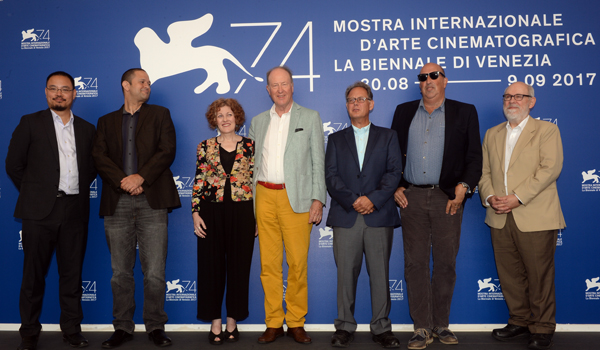
Justin Chang, Chris Vognar, Stephanie Zacharek, Peter Cowie, Ty Burr, Glenn Kenny, and DB. © La Biennale di Venezia – foto ASAC.
Posted in Festivals: Venice, Film comments |  open printable version
| No Comments » open printable version
| No Comments »
Wednesday | September 6, 2017
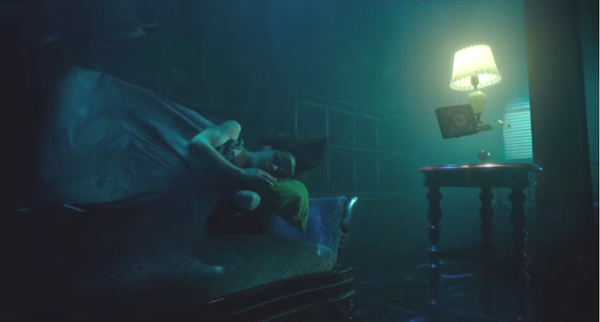
The Shape of Water.
Kristin here:
Much attention is generated each year around the Hollywood films that premiere at the big late-summer and autumn festivals, starting with Venice. This year several such films have been launched here in competition for the Leone d’Oro. David has already mentioned Downsizing, and I discuss two more below.
The Shape of Water will be released in the US on December 8, and Three Billboards outside Ebbing, Missouri on November 10. I’ve avoided giving away the endings, but there are definite SPOILERS below–though no bigger than those already present in reviews already published.
As I finish this entry, I am seated in the press room of the festival, surrounded by perhaps a couple of hundred others, all typing away like mad on their computers and tablets and turning out a great deal of coverage of the festival. The press room is a large, extremely high hall in the Casino , the second largest of the 1930s-era buildings used by the festival. It no longer functions as a casino, though there is still a pattern of clubs, hearts, diamonds, and spades on the ceiling in the press-conference room. When the festival is not on, these buildings are usually shut up and left to wait for the next year.
[September 9: Both films bagged one: The Shape of Water has just won the Golden Lion as best picture, and Three Billboards outside Ebbing, Missouri won Best Screenplay.]
The Shape of Water
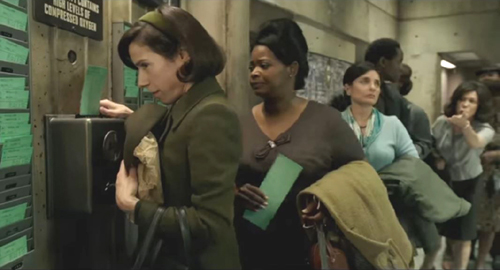
The pre-credits opening of Guillermo del Toro’s The Shape of Water shows the heroine Elisa calmly asleep, floating above a sofa in a somewhat shabbily furnished room entirely underwater (top). We hear a narrator wondering how to tell the story of “the princess without voice.” Elisa, who is a mute cleaning lady employed at a top-secret government lab in the cold-war early 1960s, is not and never becomes a princess in any literal sense. But the phrase marks the film as a fairy story in which the heroine and her true love will rescue each other. (Del Toro avoids the more obvious “Once upon a time …”)
The voice turns out to be that of Giles, a gay down-at-heels artist who is Elisa’s best friend and neighbor. He could not possibly know everything that happens, especially at the end, when his voice similarly describes the outcome. But such narrating figures are common enough, and we must make allowances in a fairy tale.
The other genres that del Toro draws upon are horror and science fiction, but both are definitely subservient to the fairy tale. The source of the horror is reversed here. The amphibious Creature who is brought to the lab and who becomes Elisa’s friend and eventual romantic partner is modeled on the Creature from the Black Lagoon, as del Toro readily admits, but here he is the victim, not the menace. The true monster is Richard Strickland, an agent who picked up “The Asset,” as he and the scientists at the lab call the creature, and he is determined to have him vivisected and disposed of–but not before he has adequate opportunity to torture the Creature with an electric cattle prod. This pastime loses Strickland two fingers, which are grafted back on but gradually go gangrenous, making him seem to degenerate into something monstrous.
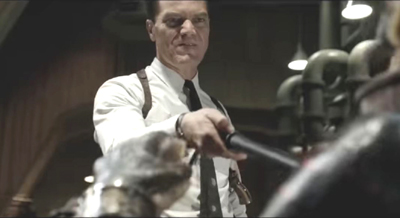
The script of The Shape of Water is elegantly crafted, with motifs wending through it, most obviously the water imagery that pervades the film, from the opening to the skittering drops of water that Elisa traces on the exterior of the bus window. Del Toro also sets up important plot points subtly and clearly. The routine of Elisa and Zelda punching in and out of work at a time clock (top of section) seems mainly a device for showing their friendship and Elisa’s somewhat loose attitude toward rigid deadlines. Later, however, the time on the punched cards ends up providing an important alibi during the investigation of the Creature’s mysterious disappearance from the lab.
Similarly, a comic scene in which janitors and cleaning ladies sneak a smoke while clustered in the blind spot of a nearby surveillance camera motivates Elisa’s later manipulation of such a camera to hide her activities during the rescue scene. The early scene of her boiling eggs to take in her brown-bag lunch leads to the episodes of her offering first a single egg and then multiple eggs to the Creature as she tries to make friends.
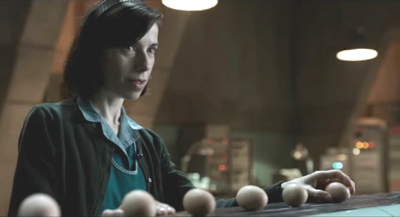
Despite all this, I found it implausible that Elisa, Zelda, and Giles, with a little help from the sympathetic scientist Hofstetler, could remove a major item from a top-secret lab. Here the fairy tale bumps up against the fact that it is set in a sci-fi world. Presumably we must simply assume that in a fairy tale such things can happen.
The music of the film is crucial to the fairy-tale atmosphere. It is entirely evocative of the late 1950s-early 1960s era, and not just in the brief scenes from real Hollywood musicals that would have been showing on TV at the time. At the press conference Alexandre Desplat (who also scored Suburbicon, competing here in Venice) said he wanted to emphasize emotions even while creating a musical flow like water, without emphatic moments. When del Toro, working as usual very quickly, showed Desplat a rough-cut of The Shape of Water a week after shooting ended, the composer referred to Nino Rota and Georges Delerue, two masters from the era of the story who were skilled at creating overtly charming soundtracks. The result is a buoyancy (to continue the water theme) that helps counteract the grimness and threat in many of the scenes.
Much has been made of the fact that del Toro has returned to his low-budget roots after Pacific Rim (at a reported $190 million budget) and Crimson Peak (mid-budget at around $55 million). The Shape of Water, according to del Toro, cost around $20 million–a remarkable figure, considering the quality of the CGI and the production design. This feat was achieved in part by the director foregoing his salary and paying for some of the conceptual artwork. (It seems likely that the cast took lower than usual fees in order to work with del Toro.)
Comparing The Shape of Water to del Toro’s masterpiece, Pan’s Labyrinth (made for a reported $19 million), is nearly universal among reviewers, and one can hardly avoid it, even though the earlier film is ultimately far darker. Perhaps it is closer to fairy tales in their original grim forms. As del Toro pointed out at the press conference, fairy tales often originated in times of war, famine, and pestilence and have been softened for modern readers. The Shape of Water never achieves the depths of queasy horror that some scenes of Pan’s Labyrinth contain. Still, it was assigned an R rating by the MPAA and is definitely a fairy tale for adults.
Three Billboards outside Ebbing, Missouri
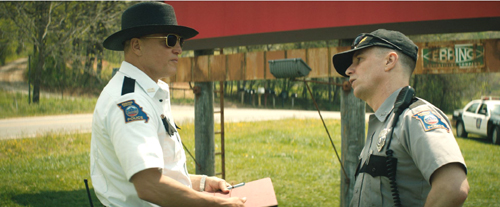
The sharp dialogue in Martin McDonagh’s third feature is funny and poignant by turns. Frances’s McDormand’s tough, vengeful mother Mildred Hayes delivers much of it and drew applause a number of times during the press screening. She begins by hiring the three billboards of the title, seen in a dilapidated state in the foggy opening shots (see bottom). Her simple message appears in three parts: “Raped while dying/And still no arrests/Why, Chief Willoughby?”
As Jason Dixon, a racist, violent, dim-witted police officer (in a scene-stealing performance by Sam Rockwell, above, with Woody Harrelson as Willoughby) observes as he drives by, this is a declaration of war. Mildred spends much of the film badgering, berating, and ultimately attacking the police for what she considers their neglect in investigating the months-old case of her daughter’s rape and murder. Most of the townspeople condemn her billboards tactic and side instead with the likeable, sensible Chief Willoughby, who is especially sympathetic given the fact that he is dying of cancer.
The “war” serves to give us yet another unsavory view of a southern town. Apart from Willoughby, who turns out not to be as inactive concerning the case or unsympathetic toward Mildred’s plight as we might think, most of the characters are unsympathetic to some degree. The other cops do little to stifle Dixon’s outbursts of violence, and Mildred’s ex-husband, who had beaten her and taken up with a pretty nineteen-year-old, disapproves of the billboard tactic. Her son just wants to put his sister’s death behind him.
Mildred herself has been pushed beyond reason by her grief, rejecting Willoughby’s protestation that his investigation has simply failed to turn up any clues, including any DNA matches among local men. Mildred’s response is to demand that he DNA test every male over eight in the town, the county, the state, the country, if necessary. When something is thrown at her car as she drops off her son at school, she actually attacks some kids who claim not to have seen who did it. Willoughby becomes the stabilizing force, and he’s not around long enough to help stave off the escalating conflict.
Three Billboards is a thoroughly entertaining film, but I think there is at least one problem involving the motivation for the presence of a mysterious stranger who becomes a suspect. On the whole the story works well, with some unexpected changes of heart among the characters and an ending that suggests the possibility of healing within the town. Perhaps this is also suggested by the choice of “Ebbing” for the fictitious Missouri town (which was represented by Sylva, Ashville, and other areas in North Carolina).
For those interested in Oscar buzz, I would not be surprised to see Frances McDormand and Sally Hawkins competing again each other in the Best Actress category. You probably did not hear that here first.
Many thanks to Peter Cowie, Alberto Barbera, Michela Lazzarin, and all of their colleagues for inviting and assisting us at this year’s Mostra.
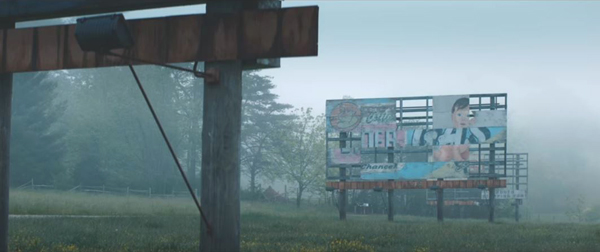
Three Billboards outside Ebbing, Missouri.
Posted in Festivals: Venice, Film comments |  open printable version
| No Comments » open printable version
| No Comments »
|











































